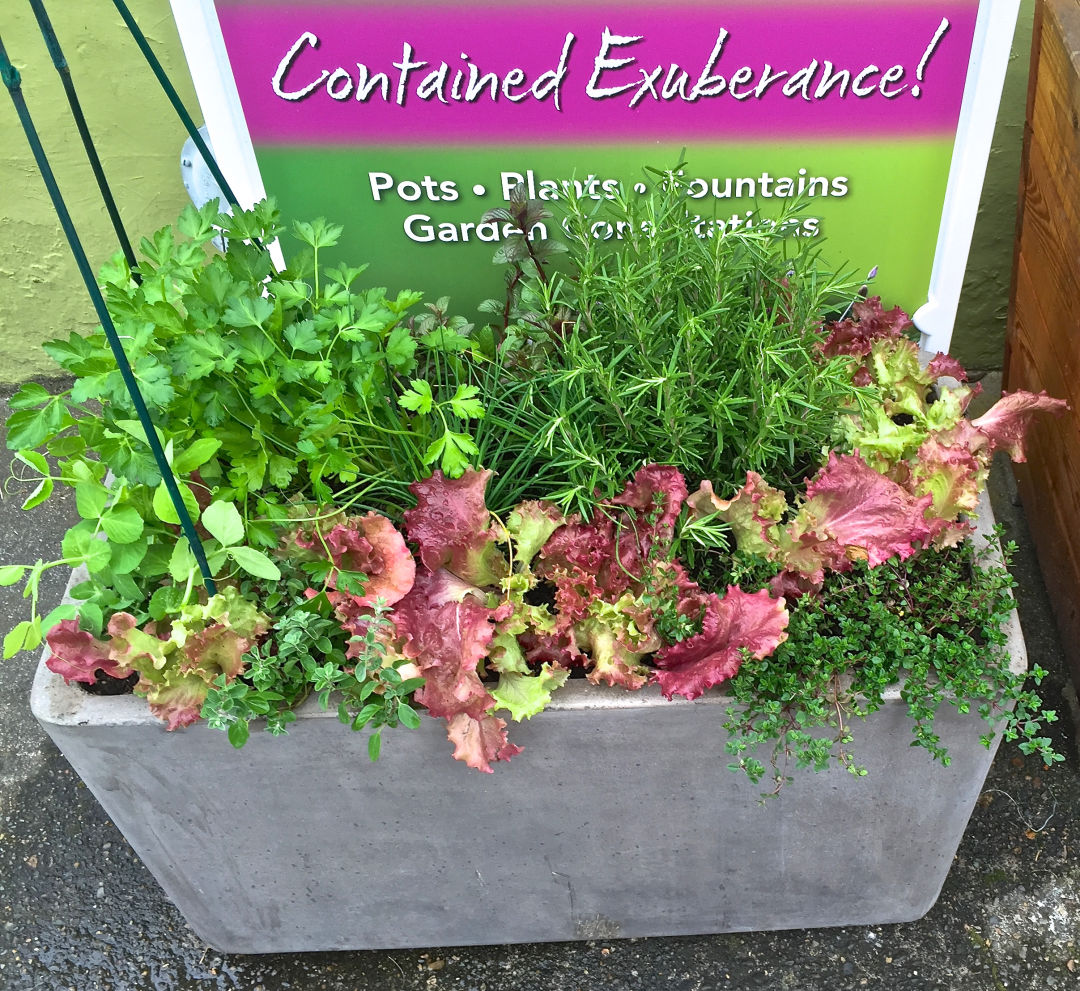Tips for Growing Edible Plants on Your Porch or Patio

In between visits to fantastic Portland Farmers Markets, you can grow and harvest delicious, nutritious herbs and vegetables in stunning pots right outside your kitchen, patio, or balcony door.
Don’t feel like you need in-the-ground space or all-day sunlight to be successful. Many leafy lettuces, Japanese mustards, radicchio, parsley, chervil, and other greens grow in a minimum of four hours of morning or afternoon sun.
At my garden design shop Contained Exuberance in southeast Portland, I work with customers to consider modular, contemporary containers and hanging planters that fit narrow balconies and tuck into small outdoor spaces. Manufacturers now offer lightweight, moveable pots in attractive, realistic finishes and patinas that are easy on the eye and your back. Fiber cement and poly-resin containers can lighten the weight load by 25% to 50% over conventional cast stone and earthenware pots – often a major consideration for highrise dwellers.
By way of demonstration, I planted this rectangular, 27.5 inch-long x 14 inch-wide x 17.25 inch-high fiber cement urban box from Campania International (www.campaniainternational.com) with an edible/ornamental mix of lettuce and herbs. The fiber cement is an eco-friendly material composed of 99% biodegradable materials including cement and jute fiber. Industrial gray in color, the trough is both frost and UV resistant.
The urban planter shown offers more soil volume and depth than required by shallow-rooted greens and herbs. To reduce the weight load and the amount and expense of bagged potting soil, I filled the bottom one third of this container with compacted plastic nursery pots (that seem to accumulate quickly this time of year in my garage!).
On top of the crushed nursery pots I placed a piece of barrier landscape fabric cut to fit the container dimensions. It prevents the soil from mixing and messing with the pot melange below. Then I emptied two 1.5 cubic-foot bags of a professional-grade sphagnum peat moss, forest humus, and composted bark potting soil mixed with volcanic pumice for good drainage.
The edible plant combination in my container design included 1 rosemary (the extra hardy variety ‘Salem’), 2 flat-leaf Italian parsley, 1 chive, 1 chocolate mint, and 2 English thymes (Thymus vulgaris) from 3-inch transplants; then the box was sown with seed of ‘Ruby Red’ leaf lettuce and sugar snap peas. The lettuce offers continual snipping for salads and the peas are trained up a small bamboo stake teepee. The herbs in this planting will quickly fill space left by harvested lettuce.

When home gardening space is at a premium, I often suggest growing edibles in hanging planters. As an alternative to wire baskets lined with a coconut fiber lining, I offer powder-coated aluminum hover dishes with stainless steel cables and swivel hook in a variety of contemporary shapes and rich colors. These are custom-designed by Pot Incorporated, Vancouver, Canada and sold in my Portland Shop.
This spring I planted a powder blue metal dish with a red-leafed Merlot lettuce accompanied by Viola cornuta with rich violet-purple flowers. Tough as nails, this violet is great in containers.
Visit with me for other creative container ideas at Contained Exuberance at Hyland Garden Design, 1114 SE Clay Street, Portland. www.hylandgardendesign.com
Bob Hyland, Hyland Garden Design LLC
